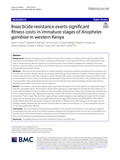Insecticide resistance exerts significant fitness costs in immature stages of Anopheles gambiae in western Kenya

View/
Date
2021-06-09Author
Osoro, Joyce K.
Machani, Maxwell G.
Ochomo, Eric
Wanjala, Christine
Omukunda, Elizabeth
Munga, Stephen
Githeko, Andrew K.
Yan, Guiyun
Afrane, Yaw A.
Metadata
Show full item recordAbstract
Background
Despite increasing documentation of insecticide resistance in malaria vectors against public health insecticides in sub-Saharan Africa, there is a paucity of information on the potential fitness costs of pyrethroid resistance in malaria vectors, which is important in improving the current resistant management strategies. This study aimed to assess the fitness cost effects of insecticide resistance on the development and survival of immature Anopheles gambiae from western Kenya.
Methods
Two-hour old, first instar larvae (L1) were introduced and raised in basins containing soil and rainwater in a semi-field set-up. Each day the number of surviving individuals per larval stage was counted and their stage of development were recorded until they emerged as adults. The larval life-history trait parameters measured include mean larval development time, daily survival and pupal emergence. Pyrethroid-resistant colony of An. gambiae sensu stricto and susceptible colony originating from the same site and with the same genetic background were used. Kisumu laboratory susceptible colony was used as a reference.
Results
The resistant colony had a significantly longer larval development time through the developmental stages than the susceptible colony. The resistant colony took an average of 2 days longer to develop from first instar (L1) to fourth instar (L4) (8.8 ± 0.2 days) compared to the susceptible colony (6.6 ± 0.2 days). The development time from first instar to pupa formation was significantly longer by 3 days in the resistant colony (10.28 ± 0.3 days) than in susceptible colony (7.5 ± 0.2 days). The time from egg hatching to adult emergence was significantly longer for the resistant colony (12.1 ± 0.3 days) than the susceptible colony (9.6 ± 0.2 days). The pupation rate (80%; 95% (CI: 77.5–83.6) vs 83.5%; 95% (CI: 80.6–86.3)) and adult emergence rate (86.3% vs 92.8%) did not differ between the resistant and susceptible colonies, respectively. The sex ratio of the females to males for the resistant (1:1.2) and susceptible colonies (1:1.07) was significantly different.
Conclusion
The study showed that pyrethroid resistance in An. gambiae had a fitness cost on their pre-imaginal development time and survival. Insecticide resistance delayed the development and reduced the survivorship of An. gambiae larvae. The study findings are important in understanding the fitness cost of insecticide resistance vectors that could contribute to shaping resistant management strategies.
URI
https://doi.org/10.1186/s12936-021-03798-9https://malariajournal.biomedcentral.com/articles/10.1186/s12936-021-03798-9
http://ir-library.mmust.ac.ke:8080/xmlui/handle/123456789/1908
Collections
- Gold Collection [1026]
